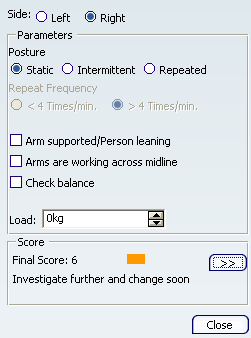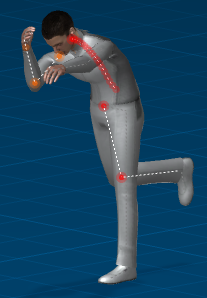About the RULA Analysis | ||
| ||
Concepts of the RULA Analysis
This describes the RULA analysis process using the RULA Analysis dialog box.
In the IK Behavior, the Optimize Criteria, IK (Inverse Kinematics) Behaviors allows you to choose to optimize the posture according to either Postural Score or RULA Analysis. This option is in effect when IK mode or Reach mode is used, as well as when the IK solver is called to resolve a constraints update. By default, the None button would be selected. Only one of the three options can be available at the same time. When the Postural Score is ON, the IK internally refers to the Postural Score and tryies to find the best score for each segment involved in the IK chain being manipulated. This requires you to apply preferred angles to these segments, before using the optimize capability. If no Preferred Angles are applied to the Manikin, then the Postural Score option would be grayed and made unavailable. When RULA is selected, then the IK would use the RULA internal preferred angles calculation (that lead to a global score when RULA is used inside the appropriate Human Activity Analysis command) to lead to an optimized posture of the involved segments during manipulation involving the IK solver. Here you do not need to explicitly apply Preferred Angles to the segments of the Manikin. However, a Human Activity Analysis license must be present in his current configuration. If This is not the case, the option for RULA would be grayed and made unavailable. See also: Using the RULA Analysis

| Command | Description | |||||||||||||||||||||||||||||||||||||||||||||||||||||||||||||||||||||
|---|---|---|---|---|---|---|---|---|---|---|---|---|---|---|---|---|---|---|---|---|---|---|---|---|---|---|---|---|---|---|---|---|---|---|---|---|---|---|---|---|---|---|---|---|---|---|---|---|---|---|---|---|---|---|---|---|---|---|---|---|---|---|---|---|---|---|---|---|---|---|
| Side: | Use the two toggle buttons to select the side of the manikin that is analyzed. | |||||||||||||||||||||||||||||||||||||||||||||||||||||||||||||||||||||
| Parameters: | Use the options in this zone to specify settings that cannot be set automatically. | |||||||||||||||||||||||||||||||||||||||||||||||||||||||||||||||||||||
| Posture | Three types of postures are predetermined:
Select the one that best describes the worker's situation. |
|||||||||||||||||||||||||||||||||||||||||||||||||||||||||||||||||||||
| Repeat Frequency | This parameter is used to determine the task
frequency. Two choices are available:
|
|||||||||||||||||||||||||||||||||||||||||||||||||||||||||||||||||||||
| Load | Use This field to specify the weight of the manipulated object. Select the arrows to increase or decrease the weight or use the keyboard to directly type a value into This field. | |||||||||||||||||||||||||||||||||||||||||||||||||||||||||||||||||||||
| Score: | There are two modes for the score display: basic mode and advanced mode. | |||||||||||||||||||||||||||||||||||||||||||||||||||||||||||||||||||||
| Basic mode | The data displayed in This mode is the final score accompanied by a
colored zone. The color of This zone changes from green to red according
to the final score. The RULA analysis examines the following risk factors: number of movements, static muscle work, force, working posture, and time worked without a break. All these factors combine to provide a final score that ranges from 1 to 7.
 |
|||||||||||||||||||||||||||||||||||||||||||||||||||||||||||||||||||||
| Advanced mode | The data displayed in the basic mode is also displayed in the advanced
mode. The advanced mode, in addition, also displays the intermediate
scores. Some of these scores are obtained by subjective values. In the
basic mode, these values are automatically set to default; in the advanced
mode you can change these values. The score is modified to
reflect these new values.
 Use the Less button
|
|||||||||||||||||||||||||||||||||||||||||||||||||||||||||||||||||||||
| Details | The Details section that is displayed when you press the More button
 presents the score
obtained for each section and used to calculate the final RULA score. The
parameters of six of these segments can be edited: presents the score
obtained for each section and used to calculate the final RULA score. The
parameters of six of these segments can be edited:
Upper arm: Shoulder elevation, Arm abduction Forearm: Arm rotation Wrist: Wrist deviation Wrist twist: Wrist twist Neck: Neck twist, Neck side-bending Trunk: Trunk twist. Trunk side-bending For each of the parameters, you have a choice of three options: Auto, Yes, and No.
These intermediate scores, represented by a number and a color, are used to calculate the final RULA score. The following table indicates the score range for each segment as well as the associated color.
G= Green Y=Yellow R=Red O=Orange For viewing the RULA Colors on the manikin, please see Segment coloring for RULA Analysis. |
|||||||||||||||||||||||||||||||||||||||||||||||||||||||||||||||||||||
| For more information on the RULA method, please read the following page that explains the steps for manually carrying the RULA evaluation. RULA Employee Assessment Worksheet | ||||||||||||||||||||||||||||||||||||||||||||||||||||||||||||||||||||||
|
For more information about customization, please see
Customizing settings RULA Specifications. For exporting the data in a report, please see Reporting Capabilities - Updating and Exporting the RULA Analysis in XML |
||||||||||||||||||||||||||||||||||||||||||||||||||||||||||||||||||||||
![]()
Concepts of Segment Coloring
This describes the concepts for segment coloring for RULA.
You is able to visualize the colors given by the RULA analysis on the manikin segment, without opening the RULA analysis dialog box. It provides another tool to visualize analysis results. You is able to control the display of colors for the RULA analysis on the manikin by setting the right coloring parameters in the manikin's coloring properties (by opening the Properties ). There are two types of coloring available for the RULA analysis. The first type, General analyzes and colors the manikin body in the two broad categories specified by RULA: Wrist Arm and Neck, Trunk and Leg. The second type, Detailed, shows colors on each individual manikin segment analyzed by RULA. See the table below. Please note that only one arm and one leg (from the same side) is colored at a time, in order to respect the RULA analysis input guidelines.

The table below illustrates the correspondence between a score in the analysis and the body part to be colored.
| Segment to be colored | RULA Analysis entry |
|---|---|
| Upper Arm | Upper Arm |
| Forearm | The worst between Forearm and Wrist Twist. That mean that if Wrist Twist is red, we take This value. Otherwise, we take the Forearm color. |
| Hand | Wrist |
| Neck (named head) | Neck |
| Trunk | Trunk |
| Thigh and leg | Leg |
The following coloring parameters is saved with the manikin:
- Analysis for coloring.
- Show Colors (None, All or All but maximum score)
- Elements to color (segments and/or surfaces)
- Type of coloring for RULA (General or Detailed).
The options titled Show Colors and Elements to color remain the same. The Degree of Freedom section is available only in the context of the Postural Score coloring. Likewise, the Type section (at the bottom of the window) is available only in the context of the RULA Analysis coloring.
The type of coloring for RULA is accessible via the Type combo. This combo is specific to the RULA analysis. The choices underneath that combination is General and Detailed, as explained.
 to switch back to
the basic mode.
to switch back to
the basic mode.